An empirical analysis on the relationship between exchange Rate and sectoral inflation in Turkey
DOI:
https://doi.org/10.5281/zenodo.7497218Keywords:
Exchange Rate, Inflation, Sectoral Inflation, Granger CausalityAbstract
There are many studies in the literature to determine the relationship between inflation and exchange rate. The direction of this relationship and the significance of the variables were examined through various econometric methods. However, it is seen that studies examining the relationship between sectoral inflation and exchange rate are insufficient in the literature. In this study, the effect of exchange rate on sectoral inflation is investigated for the case of Turkey. The main purpose of the study in this context is to reveal the effect of exchange rate on sectoral inflation in Turkey based on empirical findings within the framework of theoretical approaches. In this direction, monthly data of nominal exchange rate, inflation, domestic production index, agricultural input price index and service producer price index between the years 2017-2020 were analyzed using the Granger causality method. According to the results of the analysis, it was found that there is a causality relationship from exchange rate to inflation. On the other hand, when the results of the analysis are examined at the sectoral level, it is concluded that the changes in the exchange rate have an effect on the industrial sector, the agricultural sector and the service sector.
References
Abdurehman, A. A. ve Hacilar, S. (2016). The Relationship Between Exchange Rate and Inflation: an Empirical Study of Turkey. International Journal of Economics and FinancialIssues, 6(4), 1454-1459.https://www.econjournals.com/index.php/ijefi/article/view/2819/pdf (Erişim Tarihi: 12.12.2020).
Acar Balaylar, N. (2011). Reel Döviz Kuru İstihdam İlişkisi: Türkiye İmalat Sanayi Örneği. Sosyo Ekonomi Dergisi, 2, 137-160.https://dergipark.org.tr/tr/download/article-file/197711 (Erişim Tarihi: 05.01.2021).
Achsani, N. A., Fauzi, A. J. F. A. ve Abdullah, P. (2010). The Relationship Between Inflation and Real Exchange Rate: Comparative Study Between Asean+ 3, The EU and North America. European Journal of Economics, Finance and Administrative Sciences, 18, 1450-2275.http://achsani.blog.mb.ipb.ac.id/files/2010/11/ejefas_18_06.pdf (Erişim Tarihi: 10.01.2021).
Ali, Y. S. ve Güvenek, B. (2019). Komor Adaları’nda Dış Ticaret ve Ekonomik Büyüme İlişkisi. Uluslararası Sosyal ve Beşeri Bilimler Araştırma Dergisi, 6(48), 4540-4547.
Arslaner, F.,Karaman, D., Arslaner, N., ve Kal, S.H. (2014). The Relationship Between İnflation Targeting and Exchange Rate Pass-Through in Turkey with a Model Averaging Approach. Central Bank of the Republic of Turkey Working Paper, 14(16), 1.
Asteriou, D. and Hall, S. G. (2011), Applied Econometrics, New York: Palgrave Macmillan, Second Edition.
Aytekin, İ., ve Doyar, B. V. (2019). Türkiye’de Döviz Kuru Dalgalanmalarının Sanayi Üretimi ve Tüketici Güveni Üzerindeki Etkisi:(2008-2019), Hoca Ahmet Yesevi Uluslararası Bilimsel Araştırmalar Kongresi’nde sunulan bildiri, 913-923. Adıyaman, Türkiye.
Ayvaz, Ö. (2006). Döviz Kuru ve Hisse Senetleri Fiyatları Arasındaki Nedensellik İlişkisi. Gazi Üniversitesi İktisadi ve İdari Bilimler Fakültesi Dergisi, 8 (2), 1-14.https://dergipark.org.tr/tr/download/article-file/287553 (Erişim Tarihi: 20.03.2021).
Bozdağlıoğlu, E. Y. ve Yılmaz, M. (2017). Türkiye’de Enflasyon ve Döviz Kuru İlişkisi: 1994-2014 Yılları Arası Bir İnceleme. Bitlis Eren Üniversitesi İktisadi ve İdari Bilimler Fakültesi Akademik İzdüşüm Dergisi, 2(3), 1-20.https://dergipark.org.tr/tr/download/article-file/345356 (Erişim Tarihi: 25.03.2021).
Çelikel Danışoğlu, A. (2007), Para Krizleri: Türkiye’de Yaşanmış Krizlerin Değerlendirilmesi, Sosyal Bilimler Dergisi, (2), 1-11.https://dergipark.org.tr/tr/download/article-file/100783 (Erişim Tarihi: 04.04.2021).
Doğan, Z., Arslan, S. ve Berkman, A. (2015). Türkiye'de Tarım Sektörünün İktisadi Gelişimi ve Sorunları: Tarihsel Bir Bakış. Niğde Üniversitesi İktisadi ve İdari Bilimler Fakültesi Dergisi, 8(1), 29-41.https://dergipark.org.tr/tr/download/article-file/185141 (Erişim Tarihi: 10.04.2021).
Duman, Y. K., ve Sağdıç, A. (2019). Türkiye’de Döviz Kuru ve Enflasyon İlişkisi: Ekonometrik Bir Analiz (2003: 1–2017: 3). Sakarya İktisat Dergisi, 8(1), 1-16.https://dergipark.org.tr/tr/download/article-file/671167 (Erişim Tarihi: 06.06.2021).
Dornbusch, R. (1985). Inflation, Exchange Rates and Stabilization (No. w1739). National Bureau of Economic Research. 165, 1-28.https://ies.princeton.edu/pdf/E165.pdf (Erişim Tarihi: 29.05.2021).
Ebiringa, O. T. ve Anyaogu, N. B. (2014). Exchange Rate, Inflation and Interest Rates Relationships: An Autoregressive Distributed Lag Analysis. Journal of Economics and Development Studies, 2(2), 263-279.http://jedsnet.com/journals/jeds/Vol_2_No_2_June_2014/15.pdf (Erişim Tarihi: 18.06.2021).
Edwards, S. (2006). The Relatıonshıp Between Exchange Rates and Inflatıon Targetıng Revısıted. Working Paper 12163, Natıonal Bureau of Economıc Research, Cambridge.
https://www.nber.org/system/files/working_papers/w12163/w12163.pdf (Erişim Tarihi: 17.06.2021).
Fetai, B., Koku, P. S., Caushi, A. ve Fetai, A. (2016). The Relationship Between Exchange Rate and Inflation: The Case of Western Balkans Countries. Journal of Business, Economics and Finance, 5(4), 360-364.https://dergipark.org.tr/tr/download/article-file/378936 (Erişim Tarihi: 30.06.2021).
Gujarati, D.N. (2004). Basic Econometrics, (Fourt Edition). Boston: Mc Graw Hill.http://zalamsyah.staff.unja.ac.id/wp-content/uploads/sites/286/2019/11/7-Basic-Econometrics-4th-Ed.-Gujarati.pdf (Erişim Tarihi: 21.07.2021).
Gül, E., ve Ekinci, A. (2006). Türkiye’de Enflasyon ve Döviz Kuru Arasındaki Nedensellik İlişkisi: 1984-2003. Sosyal Bilimler Dergisi, 6(1), 91-106.
Karakaş, G. ve Erdal, G. (2017). Döviz Kuru Oynaklığının Türkiye’nin Tarımsal Dış Ticaretine Etkisi.Gıda Bilim ve Teknoloji Dergisi, 5(6), 668-675.
http://earsiv.hitit.edu.tr/xmlui/bitstream/handle/11491/3519/karakasgungorrr.pdf?sequence=1&isAllowed=y (Erişim Tarihi: 16.05.2021).
Kataranova, M. (2010). The Relationship Between The Exchange Rate and Inflation in Russia. Problems of Economic Transition, 53(3), 45-68.
https://www.researchgate.net/publication/345469122_Relationship_between_Exchange_Rate_and_Inflation_in_Russia(Erişim Tarihi: 11.03.2021).
Kristinek, J. J. ve Anderson, D. P. (2002). Exchange Rates and Agriculture: A Literature Review, Agricultural and Food Policy Center Working Paper 02-2, 1-38.https://www.afpc.tamu.edu/research/publications/373/wp-2002-02.pdf (Erişim Tarihi: 10.04.2021).
Monfared, S. S., ve Akın, F. (2017). The Relationship Between Exchage Rates and Inflation: The Case of Iran. European Journal of Sustainable Development, 6(4), 329-340.https://ecsdev.org/ojs/index.php/ejsd/article/view/574/571 (Erişim Tarihi: 03.06.2021).
Öner, H. (2018). Döviz Kuru ve Enflasyon Arasındaki Nedensellik İlişkisi: Türkiye Uygulaması. Hitit Üniversitesi Sosyal Bilimler Enstitüsü Dergisi, 11(1), 343-358.https://dergipark.org.tr/tr/download/article-file/513899 (Erişim Tarihi: 24.05.2021).
Pekmezci, A., ve Bozkurt, K. (2016). Döviz Kuru ve Ekonomik Büyüme: Türk Turizm Sektörü İçin Bir Analiz. Süleyman Demirel Üniversitesi Sosyal Bilimler Enstitüsü Dergisi, 2(24),97-108.https://dergipark.org.tr/tr/download/article-file/280560 ( Erişim Tarihi: 15.07.2021).
Sever, E. (2012). Döviz Kuru Dalgalanmalarının Tarımsal Dış Ticarette Etkisi: Türkiye Örneği. Akademik Araştırmalar ve Çalışmalar Dergisi, 4(7), 17-35.https://dergipark.org.tr/tr/download/article-file/180474 (Erişim Tarihi: 30.03.2021).
Syzdykova, A. (2016). Döviz Kuru ve Enflasyon Arasındaki İlişki: BRİC Ülkeleri Örneği. Uluslararası Yönetim ve Sosyal Araştırmalar Dergisi, 3(6), 1-14.https://dergipark.org.tr/tr/download/article-file/492872 (Erişim Tarihi: 14.01.2021).
Türk, E. (2016). Döviz Kuru Enflasyon İlişkisi “Türkiye Örneği”. Ufuk Üniversitesi Sosyal Bilimler Enstitüsü Dergisi, 5(9), 81-102.https://dergipark.org.tr/tr/download/article-file/1359125 (Erişim Tarihi: 23.02.2021).
Yıldız, A. (2014). Döviz Kuru ile Sektörel Hisse Senedi Endeksleri Arasındaki İlişki. Finans Politik ve Ekonomik Yorumlar, 51(593), 77-91.
TCMB, Elektronik Veri Dağıtım Sistemi,https://evds2.tcmb.gov.tr, (Erişim Tarihi: 12.03.2021)
TÜİK, İstatistikler, https://www.tuik.gov.tr, (Erişim Tarihi: 05.03.2021)
Downloads
Published
How to Cite
Issue
Section
License
Copyright (c) 2021 Journal of Academic Opinion

This work is licensed under a Creative Commons Attribution 4.0 International License.





